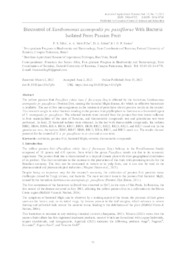Biocontrol of Xanthomonas axonopodis pv. passiflorae With Bacteria Isolated From Passion Fruit.
Biocontrol of Xanthomonas axonopodis pv. passiflorae With Bacteria Isolated From Passion Fruit.
Author(s): SILVA, F. S.; MELO FILHO, A. A.; SCHURT, D. A.; SANTOS, I. G. P.
Summary: The yellow passion fruit Passiflora edulis Sims f. flavicarpa Deg is affected by the bacterium Xanthomonas axonopodis pv. passiflorae (Pereira) Dye, causing the bacterial blight disease, for which no effective bactericide is available. The use of live microorganisms in the treatment of pests have shown positive results in the control. This research sought to select bacteria residing in the passion fruit phyllosphere to function as a biocontrol agent of X. axonopodis pv. passiflorae. The selected bacteria were isolated from the passion fruit tree leaves collected in four municipalities of the state of Roraima, and thermostable compounds test and greenhouse test were performed. In total, 28 bacterial isolates were obtained. In the test with thermostable compounds, the isolates RR02, RR04, RR06, RR14, RR16, RR17, RR19, RR20, RR21, RR22, RR23, RR25, and RR27 stood out. In the greenhouse tests, the isolates RR03, RR07, RR09, RR13, RR16, RR21, and RR23 stood out. The results showed potential for the control of X. a. pv. passiflorae in in vitro and in vivo tests.
Publication year: 2023
Types of publication: Journal article
Unit: Embrapa Roraima
Keywords: Antibiosis, Bacterial blight, Passion fruits, Severity, Thermostable compounds
Observation
Some of Embrapa's publications are published as ePub files. To read them, use or download one of the following free software options to your computer or mobile device. Android: Google Play Books; IOS: iBooks; Windows and Linux: Calibre.
Access other publications
Access the Agricultural Research Database (BDPA) to consult Embrapa's full library collection and records.
Visit Embrapa Bookstore to purchase books and other publications sold by Embrapa.

